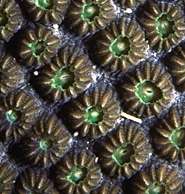Orbicella faveolata
| Orbicella faveolata | |
|---|---|
%2C_p%C3%B3lipos_abiertos.jpg) | |
| Scientific classification | |
| Kingdom: | Animalia |
| Phylum: | Cnidaria |
| Class: | Anthozoa |
| Order: | Scleractinia |
| Family: | Merulinidae |
| Genus: | Orbicella |
| Species: | O. faveolata |
| Binomial name | |
| Orbicella faveolata (Ellis and Solander, 1786)[2] | |
| Synonyms | |
|
Montastraea faveolata (Ellis & Solander, 1786) | |
Orbicella faveolata, commonly known as mountainous star coral, is a colonial stony coral in the family Merulinidae. It is native to the Caribbean Sea and the Gulf of Mexico and is listed as "endangered" by the International Union for Conservation of Nature. This species used to be known as Montastraea faveolata.
Description

Colonies of this coral are solid and very large, forming a mound with a skirt. The surface is smooth and undulating, with small lumps, bulges or lobes. The corallites, the stony cups in which the polyps sit, are about 5 mm (0.2 in) in diameter and cover the entire surface of the coral. The colour is usually pale brown but may be deep brown with fluorescent green highlights.[3] This coral is part of a species complex including the closely related Orbicella annularis and Orbicella franksi, but the former has more distinct nodules or small columns and the latter has a more irregular, lumpy surface.[3]
Distribution and habitat
Orbicella faveolata occurs in shallow waters in the Caribbean Sea and the Gulf of Mexico, its range including Florida, the Bahamas, Venezuela and possibly Bermuda. It is found on both the back reef and fore reef slopes of fringing reefs at depths of up to 30 m (98 ft). It is often the most abundant coral species on fore reef slopes between 10 and 20 m (33 and 66 ft).[1]
Biology
Like other corals, Orbicella faveolata has a symbiotic relationship with a dinoflagellate in the genus Symbiodinium. These symbionts are commonly known as zooxanthellae and large numbers are present in the coral's living tissue. Several different species of Symbiodinium associate with the coral, depending on the degree of light intensity reaching the part of the surface where they reside. When artificial shading was applied by researchers to corals for some weeks, the Symbiodinium died out in the shaded portion. When the light was restored, zooxanthellae became reinstated, but in many instances, the original species was replaced by a different species of Symbiodinium.[4]
The surface of the coral can be considered a microbiome, an ecological community of micro-organisms. The zooxanthellae, bacteria and archaea present vary with the time of year and in the spring (but not the autumn) their composition is also affected by the health of the coral and whether it is suffering from yellow-band disease.[5]
Status
Orbicella faveolata is a slow-growing species and the rate at which new colonies are formed is less than the rate at which mature colonies die. It is susceptible to bleaching and to several coral diseases including yellow-band disease, black band disease and plague.[1] Numbers of individuals are believed to have declined by over 50% in the last thirty years and the International Union for Conservation of Nature lists its conservation status as being "endangered".[1]
References
- 1 2 3 4 Aronson, R.; Bruckner, A.; Moore, J.; Precht, B.; Weil, E. (2008). "Montastraea faveolata". IUCN Red List of Threatened Species. Version 2013.2. International Union for Conservation of Nature. Retrieved 2015-01-30.
- ↑ Hoeksema, Bert (2014). "Orbicella faveolata (Ellis & Solander, 1786)". World Register of Marine Species. Retrieved 2015-06-14.
- 1 2 "Montastraea faveolata". Coralpedia. University of Warwick. Retrieved 2015-01-30.
- ↑ Toller, W. W.; Rowan, R.; Knowlton, N. (2001). "Repopulation of Zooxanthellae in the Caribbean Corals Montastraea annularis and M. faveolata following Experimental and Disease-Associated Bleaching". Biological Bulletin. 201 (3): 360–373. JSTOR 1543614.
- ↑ Kimes, N.E.; Johnson, W.R.; Torralba, M.; Nelson, K.E; Weil, E.; Morris, P.J. (2013). "The Montastraea faveolata microbiome: ecological and temporal influences on a Caribbean reef-building coral in decline". Environmental Microbiology. 15 (7): 2082–2094. doi:10.1111/1462-2920.12130. PMID 23750924.
